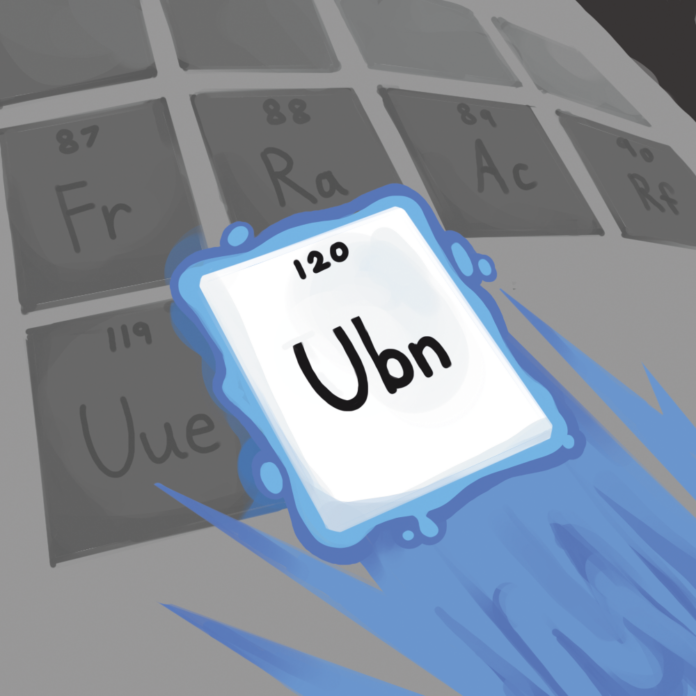Research from the Lawrence Berkeley Lab hints at a new way to create element 120
By NAREN KRISHNA JEGAN — science@theaggie.org
Recent news from the Lawrence Berkeley National Laboratory has demonstrated a new way to create superheavy element 116 (livermorium) using a 50-titanium beam targeting a 244-plutonium atom. Using the same technique, these same researchers intend to create element 120, marking the first new element discovery in over 20 years. Dr. Jacklyn Gates, the lead researcher at the Lawrence Berkeley Lab, and Dr. Eric Prebys, the head of the Crocker Nuclear Laboratory at UC Davis, discussed these findings.
A Crash Course on Atomic Theory
Atoms are composed of three subatomic particles: positively charged protons, neutrally charged neutrons and negatively charged electrons. The protons and neutrons are clustered together in the center of the atom — the nucleus — while the electrons are found flying around the nucleus.
The number of protons in an atom determines the name of the element. While changing the number of protons changes the physical name of the element and thereby its properties, changing the number of neutrons or electrons does not change the element.
Changing the number of electrons causes a change in the overall charge of the atom; if the total number of electrons is not equal to the number of protons, it’s an atomic ion.
You can create either an overall positive or negative charge by removing electrons from a neutral atom or adding more electrons to an atom while maintaining a constant number of protons, respectively. Changing the number of neutrons in an atom while keeping the proton and electron count constant creates atomic isotopes — alternative forms of the same element that can display certain forms of decay due to instability.
New research
Gates said that although superheavy elements — chemical elements with an atomic number larger than 104 — do not have many applications, the creation of these elements suggests an expansive future of discovery.
“[The creation of these elements] allows us to refine our understanding of atomic theory and what happens on a small scale,” Gates said. “Elements are the building blocks of everything that we have here on Earth […] We are focused on what are the limits of those building blocks — how big of a block can you make and where can you stop?”
Prebys said that in order to create these building blocks, there needs to be the right mix of substances such as concrete, water, sand and gravel to create a stable structure.
“Once you get past uranium, elements are not stable,” Prebys said. “However, there’s this belief that if you get heavy enough, there’s an island of stability.”
The island of stability refers to the certain combinations of protons, neutrons and electrons that create relatively stable elements that one can determine the atomic properties of — the most stable compositions consist of magic numbers, a certain amount of protons and neutrons.
In order to physically create an element, high-energy beams need to bombard a target. The Lawrence Berkeley Lab applied this principle to create element 116 by shooting high-energy titanium-50 beams into plutonium-244 to create a fusion reaction that produces livermorium-290.
Prebys said that using beams is pivotal to create elements.
“Nuclei are repulsive,” Prebys said. “You can’t make two protons stick together because they are repulsive. However, the stronger nuclear forces overpower the electromagnetic forces only at considerably small distances.”
The nuclear force causes naturally repulsive protons to stick together in a high-energy interaction; In order to break something of high energy, you would need greater amounts of energy.
Currently, one of the most common ways to create superheavy elements is to use calcium-48 beams. This method has only been used to create elements up to element 118 (oganesson). However, by irradiating the titanium-50 isotope and shooting it into beams of plutonium–244, Gates’ team was able to create livermorium-290.
The choice to use titanium-50 is due to it being doubly magic — meaning that the atom contains a magic number for both protons and neutrons. By pairing this with the plutonium-244 isotope, the most stable isotope of plutonium, the researchers were able to expect a higher percentage of a detectable reaction. By bombarding titanium-50 to the californium-249 isotope and accounting for some decay patterns, the team aims to create element 120. Because of titanium-50’s inherent stability, coupled with its higher tendency to create nuclear fusion reactions, Gates and her team hope to push beyond the current scope of our periodic table.
If successful, this work can open up new avenues for nuclear research. Scientists can explore the multitude of ways to create superheavy elements that last for longer periods of time, enabling us to better understand the atomic theory that governs them and their potential applications.
Written by: Naren Krishna Jegan — science@theaggie.org





